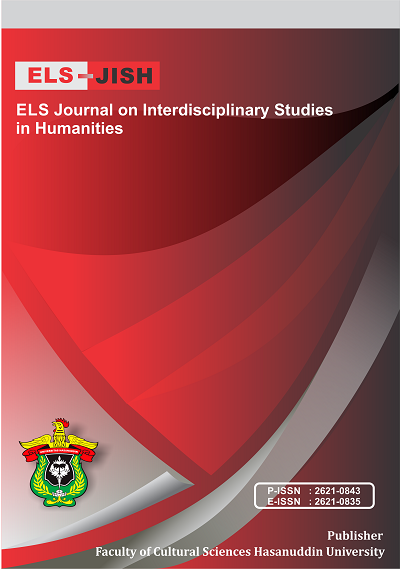Unveiling Political Persuasion: Speech Acts in the 2024 Indonesian Presidential Candidates' Speech Texts
DOI:
https://doi.org/10.34050/elsjish.v7i1.34225Keywords:
Speech Acts, Persuasiveness, Propaganda, Presidential Candidates, Speech TextsAbstract
This research aims to describe the forms of persuasion and types of political propaganda carried out by the three Candidates for President of the Republic of Indonesia in 2024. This type of research is a theoretical and methodological approach by analyzing words, phrases, clauses and sentences containing persuasive speech acts in the text speeches by three Indonesian Presidential Candidates in 2024. The sampling technique in this research was based on predetermined criteria. The results of this research obtained the use of imperative sentences by presidential candidates are more about requests, prohibitions and omissions. This shows that the presidential candidate is a speaker who positions himself lower than his speech partner (audience). For this reason, the Presidential Candidate in his speeches always asks and hopes for the people to be accepted and accepted in society. Meanwhile, the political propaganda carried out by the presidential candidates is based on the vision and mission in their speeches. They asked and expected the people to accept and follow what was in the contents of their speech. The presidential candidates' speeches are political propaganda speeches that can be combined with a vision and mission and then carried out persuasively.Downloads
References
Arifin, A. (2011). Komunikasi politik: filsafat, paradigma, teori, tujuan, strategi, dan komunikasi politik Indonesia. Graha Ilmu.
Arifin, H. Z., Wibowo, W., & Sosrohadi, S. (2010). Bahasa Indonesia Akademik: Mata Kuliah Pengembangan Kepribadian. Tangerang: PT. Pustaka Mandiri.
Ariyanti, L.D., & Zulaeha, I. (2017). Tindak Tutur Ekspresif Humanis dalam Interaksi Pembelajaran di SMA Negeri 1 Batang: Analisis Wacana Kelas. Jurnal Seloka. 6(2), 111- 122.
Azizah, S. N., & Rustono, R. (2020). Tuturan Ilokusi dalam Wacana Pidato Kampanye Prabowo Subianto pada Pemilu 2019. Jurnal Sastra Indonesia, 9(2), 144-150.
Bakir, V., Herring, E., Miller, D., & Robinson, P. (2019). Organized Persuasive Communication: A new conceptual framework for research on public relations, propaganda and promotional culture. Critical Sociology, 45(3), 311-328.
Chaer, A. & Agustina, A. (2014). Sosiolinguistik Perkenalan Awal. Jakarta: Rineka Cipta.
Devito, J. A. (2011). Komunikasi Antar Manusia. Tangerang: Karisma Publishing Group.
Dewi, I. G. A. R. S., Suandi, I. N., Hum, M., & Wisudariani, N. M. R. (2016). Jenis, Bentuk, dan Fungsi Tindak Tutur Meme Comic pada Facebook. Jurnal Pendidikan Bahasa dan Sastra Indonesia Undiksha, 5(3) Availabe on darihttps://ejournal.undiksha.ac.id/index.php/JJPBS/article/ view/8777/5693.
Effendy, L. (2020). The role of institution and innovation attributes in the adoption of integrated crop management technology of lowland rice of West Bandung and Sumedang districts. International Journal of Multicultural and Multireligious Understanding, 7(4), 279-293.
Hadi, S. (2012). The Effect of Using Cause and Effect Technique toward the Students’ Reading Comprehension of the Persuasive Text at The Second Year of SMA PGRI Pekanbaru (Doctoral dissertation, Universitas Islam Negeri Sultan Syarif Kasim Riau).
Irwani, I. (2021). Tindak Tutur Persuasif Berbahasa Bugis Pada Poster Covid-19 di Kabupaten Maros (Doctoral dissertation, Universitas Hasanuddin).
Keraf, G. (2010). Argumentasi dan Narasi. Jakarta: Gramedia.
Liputan6. (2023). Pidato Lengkap Ganjar Pranowo Usai Ditunjuk Megawati Jadi Capres PDIP. https://youtu.be/FK30Xx2JmPM
Maulana, H., & Gumelar, G. (2013). Psikologi komunikasi dan persuasi. Jakarta: Akademia Permata.
Maharani, A.T. & Utomo, A.P.Y. (2020). Analisis Tindak Tutur Lokusi Dalam Akun Twitter Fiersa Besari. Jurnal Metafora, 6(2).
McCrimmon. (1984). Writing With a Purpose. 8th edition. Boston: Houghton Mifflin.
Paramita, N.T. & Utomo, A.P.Y. (2020). Analisis Tindak Tutur Ekspresif Radio Prambors Program Sapa Mantan. Jurnal CARAKA, 6(2).
Rahman, F., & Weda, S. (2019). Linguistic deviation and the rhetoric figures in Shakespeare’s selected plays. XLinguage" European Scientific Language Journal", 12(1), 37-52.
Sosrohadi, S., & Wulandari, D. (2022). Character Discrimination Analysis in the Novel Maryam by Okky Madasari. ELS Journal on Interdisciplinary Studies in Humanities, 5(2), 187-197.
Sukmawaty, Rahman, F. F., & Andini, C. (2022). Covid-19 Pandemic and Axiology of Communication: A Study of Linguistic Phenomena. IJISRT, 7(4), 1079-1087.
Suma, M., Rahman, F., Dalyan, M., Rahman, F. F., & Andini, C. (2023). Literature And Family Development: A Character Building Education. Journal of Namibian Studies: History Politics Culture, 39, 220-232.
Tarigan, H. G. (2015). Berbicara Sebagai Suatu Keterampilan Berbahasa. Bandung: Angkasa.
Taufik, K. S. (2013). Wujud-Wujud Tuturan Persuasif Dalam Kampanye Pemilihan Bupati Dan Wakil Bupati Pasuruan Tahun 2008 Ditinjau Dari Perspektif Tindak-Tutur. Prosodi, 7(2).
Downloads
Published
How to Cite
Issue
Section
License
Copyright (c) 2024 Somadi Sosrohadi, Muhammad Syukri, Andri Arismanto Sosrohadi

This work is licensed under a Creative Commons Attribution-ShareAlike 4.0 International License.

















